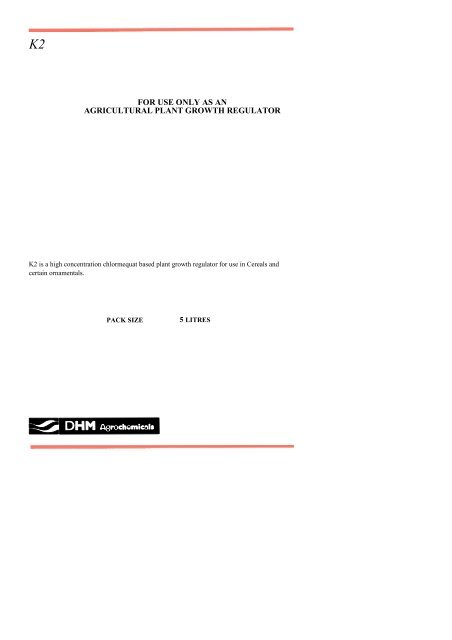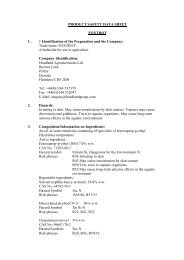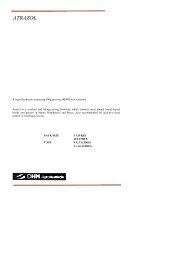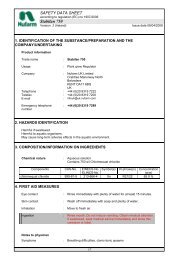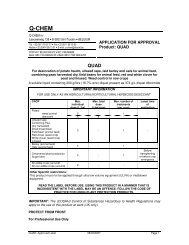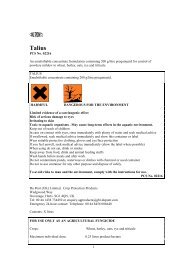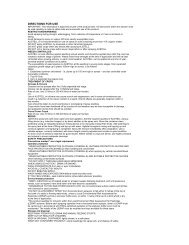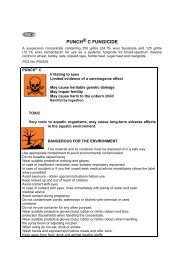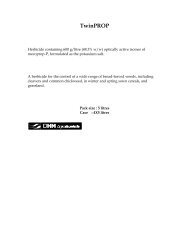K2 - Dhm.ie
K2 - Dhm.ie
K2 - Dhm.ie
Create successful ePaper yourself
Turn your PDF publications into a flip-book with our unique Google optimized e-Paper software.
<strong>K2</strong><br />
FOR USE ONLY AS AN<br />
AGRICULTURAL PLANT GROWTH REGULATOR<br />
<strong>K2</strong> is a high concentration chlormequat based plant growth regulator for use in Cereals and<br />
certain ornamentals.<br />
PACK SIZE<br />
5 LITRES
<strong>K2</strong><br />
GENERAL COMMENTS : ‘The effects of <strong>K2</strong> on plant growth can result in y<strong>ie</strong>ld increase and a<br />
reduction in early lodging from a spring application. This control of lodging is more consistent in wheat<br />
than in barley.’<br />
TIME OF APPLICATION TO AUTUMN SOWN CROPS (WHEAT AND BARLEY)<br />
Apply <strong>K2</strong> during tillering, but not later than leaf sheath erect stage (when the leaf sheaths on half of the<br />
main shoots have reached 5cm (2") measured from ground level to the base of the uppermost leaf blade)<br />
but before the first node is detectable (Zadoks 31). This is likely to be between mid-February and mid-<br />
April. Best results have been obtained from applications made before the end of March in all autumn<br />
sown crops.<br />
TIME OF APPLICATION TO SPRING SOWN CROPS (WHEAT ONLY)<br />
Apply <strong>K2</strong> during tillering, but before the first node is detectable on half of the main stems. This will<br />
usually mean treating the crop between 15 and 35 days after 50% emergence, especially in late drilled<br />
spring crops.<br />
RATE OF APPLICATION<br />
WINTER WHEAT Apply <strong>K2</strong> at 1.0 litres per hectare (0.7 pints per acre)<br />
SPRING WHEAT Apply <strong>K2</strong> at 0.9 litres per hectare (0.64 pints per acre)<br />
WINTER BARLEY Apply <strong>K2</strong> at 1.25 litres per hectare (0.9 pints per acre)<br />
APPLICATION VOLUME<br />
Apply the recommended rate of <strong>K2</strong> in at least 200 litres of water per hectare (18 gallons per acre).<br />
MIXING<br />
Shake well before use. Add <strong>K2</strong> to a half-filled tank. Top up tank to the required volume and ensure<br />
thorough mixing before and during spraying.<br />
CAUTION<br />
Do not use in tank mixture with liquid nitrogen fertiliser.<br />
APPLICATION CONDITIONS<br />
Do not apply <strong>K2</strong> to crops under stress from waterlogging, drought, or nutr<strong>ie</strong>nt defic<strong>ie</strong>ncy. In hot, dry<br />
weather a better result might be obtained from application in the early morning or evening.<br />
CAUTION<br />
Although <strong>K2</strong> may be used under normal seasonal temperature (down to 1° C) and ground conditions, it<br />
should not be sprayed onto plants covered with frost and requires two hours before rain or frost occurs<br />
for a good effect to be obtained. Do not allow <strong>K2</strong> to drift onto neighbouring crops.<br />
UNDERSOWN CROPS<br />
<strong>K2</strong> may be used on crops undersown with clovers and grasses.<br />
VARIETAL RESTRICTIONS<br />
There are no var<strong>ie</strong>tal restrictions on the use of <strong>K2</strong><br />
SEED CROPS<br />
<strong>K2</strong> may be used on all var<strong>ie</strong>t<strong>ie</strong>s of wheat and barley grown under the Seed Certification Scheme but<br />
growers are advised to consult the guidelines laid down in the Seed Certification Scheme’s<br />
“Certification of Seed of Wheat, Barley and Oats”.
<strong>K2</strong><br />
USE OF STRAW<br />
There are no restrictions on the use of straw from crops treated with <strong>K2</strong>.<br />
COMPATIBILITY<br />
Herbicides - Provided that all product recommendations are followed, <strong>K2</strong> is compatible with<br />
the following products: amidosulfuron (MAFF 07318), benazolin + bromoxynil + ioxynil<br />
(MAFF 07243), benazolin + 2,4-DB + MCPA (MAFF 05623), benazolin + 2, 4-DB + MCPA<br />
(MAFF 07841), bentazone + MCPA + MCPB (MAFF 00028), bromoxynil + fluroxypyr (MAFF<br />
01587), bromoxynil + fluroxypyr + ioxynil (MAFF 05173), bromoxynil + ioxynil (MAFF<br />
07313), bromoxynil + ioxynil (MAFF 06201), bromoxynil + ioxynil + mecoprop-P (MAFF<br />
08150), bromoxynil + ioxynil + triasulfuron (MAFF 06117), chlorotoluron (MAFF 05779),<br />
chlorotoluron (MAFF 03059), clodinafop-propargyl (MAFF 07763), clodinafop-propargyl +<br />
diflufenican (MAFF 08128), clodinafop-propargyl + trifluiralin (MAFF 08030), clopyralid<br />
(MAFF 05578), clopyralid + fluroxypyr + ioxynil (05185), cyanazine (MAFF 07009), 2, 4-D<br />
(MAFF 01391), 2 4-D (MAFF 01393), 2 4-D (MAFF 07699), 2, 4-D (MAFF 08050),<br />
dichlorprop (MAFF 01394), diclofop-methyl (MAFF 07323), diclofop-methyl + fenoxaprop-Pethyl<br />
(MAFF 07337), difenzoquat (MAFF 03241), diflufenican + isoproturon (MAFF 06200),<br />
diflufenican + isoproturon (MAFF 06491), fenoxaprop-ethyl (MAFF 07308), fenoxaprop-P-ethyl<br />
(MAFF 07309), fenoxaprop-P-ethyl + isoproturon (MAFF 07332), flamprop-M-isopropyl<br />
(MAFF 07005), fluroxypyr (MAFF 05496), imazamethabenz-methyl (MAFF 03737),<br />
isoproturon (MAFF 08100), isoproturon (MAFF 06172), isoproturon (MAFF 07695),<br />
isoproturon + pendimethalin (MAFF 03687), linuron (MAFF 07862), MCPA (MAFF 00209),<br />
MCPA (MAFF 07717), MCPA (MAFF 08100), MCPB (MAFF 07522), mecoprop (MAFF<br />
02918), mecoprop (MAFF 06037), mecoprop-P (MAFF 05889), methabenzthiazuron (MAFF<br />
02169), metoxuron (MAFF 00754), metsulfuron-methyl (MAFF 02977), metsulfuron-methyl +<br />
thifensulfuron-methyl (MAFF 03990), pendimethalin (MAFF 08152), pendimethalin (MAFF<br />
04183), thifensulfuron-methyl + tribenuron-methyl (MAFF 07795), tralkoxydim (MAFF 06675),<br />
triasulfuron (MAFF 05993), tribenuron-methyl (MAFF 06270), trifluralin (MAFF 05313),<br />
trinexapac-ethyl (MAFF 07830).
<strong>K2</strong><br />
Fungicides - Provided that all product recommendation are followed, <strong>K2</strong> is compatible with<br />
the following products: azoxystrobin(MAFF 08517), benomyl (MAFF 00229), bromuconazole<br />
(MAFF 08268), carbendazim (MAFF 03848), carbendazim (MAFF 07315), carbendazim (MAFF<br />
02752), carbendazim + chlorothalonil (MAFF 05119), carbendazim + flutriafol (MAFF 06659),<br />
carbendazim + prochloraz (MAFF 07225), carbendazim + propiconazole (MAFF 01050),<br />
carbendazim + propiconazole (MAFF 04968), chlorothalonil (MAFF 05544), chlorothalonil<br />
(MAFF 08366), cyproconazole (MAFF 05065), cyproconazole (MAFF 08354), cyproxonazole +<br />
prochloraz (MAFF 07431), cyproconazole + quinoxyfen (MAFF 08960), cyprodinil (MAFF<br />
08764), epoxiconazole (MAFF 07236), epoxiconazole + fenpropimorph (MAFF 07362),<br />
epoxiconazole + kresoxim-methyl (MAFF 08889), epoxiconazole + kresoxim-methyl +<br />
fenpropimorph (MAFF 08886), epoxiconazole + tridemorph (MAFF 07363), fenpropidin (MAFF<br />
06693), fenpropidin (MAFF 07933), fenpropimorph (MAFF 00578), fenpropimorph (MAFF<br />
06943), fenpropimorph + flusilazole (MAFF 06783), fenpropimorph + kresoxim-methyl (MAFF<br />
08362), fenpropimorph + propiconazole (MAFF 05715), fenpropimorph + quinoxyfen (MAFF<br />
08241), flusilazole (MAFF 08237), iprodione (MAFF 06328), mancozeb (MAFF 04255),<br />
mancozeb (MAFF 06320), maneb (MAFF 01276), nuarimol (MAFF 05502), prochloraz (MAFF<br />
07287), propiconazole (MAFF 02138), propiconazole (MAFF 06747), quinoxyfen (MAFF<br />
08279), sulfur (MAFF 05572), sulfur (MAFF 04707), sulfur (MAFF 04050), tebuconazole<br />
(MAFF 08691), tebuconazole + triadimenol (MAFF 06387), tebuconazole + tridemorph (MAFF<br />
06468), triadimefon (MAFF 00221), triadimenol (MAFF 02672), triadimenol + tridemorph<br />
(MAFF 08361), tridemorph (MAFF 00369).<br />
Insecticides - Provided that all product recommendations are followed, <strong>K2</strong> is compatible with<br />
the following products: chlorpyrifos (MAFF 01992), chlorpyrifos (MAFF 07815), cypermethrin<br />
(MAFF 06632), cypermethrin (MAFF 04119), cypermethrin (MAFF 07680), deltamethrin<br />
(MAFF 01712), demeton-S-methyl (MAFF 08017), dimethoate (MAFF 00199), dimethoate<br />
(MAFF 01527), dimethoate (MAFF 07351), lambda-cyhalothrin (MAFF 06434), pirimicarb<br />
(MAFF 06633), pirimicarb (MAFF 06922).<br />
Adjuvants – SPRAYSEAL<br />
Foliar Fertiliser - When using <strong>K2</strong> with a foliar fertiliser thoroughly mix the <strong>K2</strong> before adding<br />
foliar fertiliser to the spray tank.
<strong>K2</strong><br />
SAFETY DATA SHEET<br />
1. Identification of the substance/preparation and of the<br />
company/undertaking.<br />
PRODUCT NAME<br />
COMPANY<br />
Eastleigh,<br />
<strong>K2</strong><br />
Mandops (UK) Limited, 36 Leigh Road,<br />
Hampshire, SO50 9DT<br />
Tel: 01703 641826<br />
Fax: 01703 629106<br />
2. Composition/information on ingred<strong>ie</strong>nts<br />
ACTIVE INGREDIENT Chlormequat (620 g/litre aqueous solution)<br />
(2-chloroethyltrimethylammonium chloride)<br />
CAS NO [999-81-5]<br />
EC NO 213-666-4<br />
EC SYMBOL LETTER<br />
Xn<br />
3. Hazards identification<br />
FIRE<br />
HEALTH<br />
ENVIRONMENT<br />
Does not present a fire hazard.<br />
Harmful in contact with skin and if swallowed.<br />
None reported.<br />
4. First aid measures<br />
EYES<br />
SKIN<br />
persists.<br />
INGESTION<br />
Keeping eyelids open, irrigate well with eye wash<br />
solution or copious amounts of water without delay.<br />
Obtain medical attention at once.<br />
Remove contaminated clothing and wash skin well<br />
with soap and water.<br />
Obtain medical attention if irritation occurs and<br />
Do not induce vomiting. Wash out mouth with water<br />
and give water (0.25 litres) to drink. Keep pat<strong>ie</strong>nt at<br />
rest and obtain medical attention at once.
<strong>K2</strong><br />
SAFETY DATA SHEET cont..<br />
5. Fire-fighting measures<br />
EXPOSURE HAZARD<br />
SUITABLE EXTINGUISHERS<br />
OTHER ADVICE<br />
If involved in a fire, it will emit fumes containing toxic<br />
nitrogen and chlorine compounds.<br />
Firefighting personnel should wear standard chemicalresistant<br />
protective suit and self-contained breathing<br />
apparatus.<br />
Product is not combustible. Fight fire with carbon dioxide,<br />
foam or water spray, as suitable for other, combustible,<br />
materials involved .<br />
If without risk, remove unopened packages from exposure to fire.<br />
Otherwise spray unopened containers with water to keep cool.<br />
Do not let fire-fighting water contaminate drains or watercourses.<br />
6. Accidental release measures<br />
PERSONAL PRECAUTIONS<br />
ENVIRONMENTAL PRECAUTIONS<br />
OTHER PRECAUTIONS<br />
CLEAN-UP METHODS<br />
Wear protective equipment described in Section 8. Do<br />
not eat drink or smoke. Avoid contact with chemical.<br />
Prevent spillages from entering drains or sewers (inform<br />
local water authority if this occurs), or rivers or other<br />
watercourses (inform National Rivers Authority if this<br />
occurs).<br />
Cordon off area. Keep people and animals away.<br />
Absorb/contain liquid spillages in sand, earth or<br />
propr<strong>ie</strong>tary absorbent, shovel up and place in plastic<br />
drums for subsequent safe disposal (see Section 13).<br />
7. Handling and storage<br />
HANDLING<br />
STORAGE<br />
No special precautions are necessary if unopened packs are handled with<br />
care. When handling in a usage context, refer to usage instructions. When<br />
handling in a spillage context, refer to Sections 3, 6 and 8. In all cases,<br />
before attempting to handle packages manually, refer to assessments made<br />
under the Manual Handling Regulations. Wash hands thoroughly before<br />
eating, drinking or smoking and after work.<br />
No special precautions required. Pesticides should be stored in a locked<br />
designated pesticide store, away from children, animals, food, drink, animal<br />
feeding stuffs and other chemicals. Rotate stock and examine regularly for<br />
leakages.<br />
8. Exposure controls/personal protection<br />
ENGINEERING CONTROLS<br />
Wherever possible, exposure should be eliminated or minimised<br />
using appropriate engineering controls such as physical<br />
containment and good ventilation.
<strong>K2</strong><br />
SAFETY DATA SHEET cont..2<br />
UK EH40 OCCUPATIONAL<br />
EXPOSURE STANDARDS Product - none.<br />
RESPIRATORY<br />
HAND<br />
EYE<br />
SKIN<br />
None required when handling the concentrate.<br />
Plastic or rubber gloves or gauntlets.<br />
Goggles, with side protection, or visor.<br />
Chemical resistant non-adsorbent overalls and rubber or PVC wellington boots.<br />
NOTE<br />
If possible decontaminate protective clothing before removal. Some of the above protective<br />
equipment may be inappropriate when small quantit<strong>ie</strong>s of product are involved. Obtain expert advice before disregarding.<br />
9. Physical and chemical propert<strong>ie</strong>s<br />
APPEARANCE<br />
ODOUR<br />
Yellow-brown liquid<br />
Strong fishy<br />
DECOMPOSITION TEMP 200°C<br />
BOILING TEMPERATURE 100°C<br />
VAPOUR PRESSURE<br />
Aqueous, similar to water.<br />
DENSITY (g/ml) 1.136<br />
SOLUBILITY IN WATER<br />
PARTITION COEFFICIENT<br />
POUR POINT<br />
Miscible<br />
N/A<br />
N/A<br />
AUTOIGNITION<br />
TEMPERATURE<br />
Not<br />
combustible<br />
VISCOSITY (mPa @ 20°C) Not known<br />
pH 6.5-7.5<br />
EXPLOSION POTENTIAL No<br />
OXIDISING POTENTIAL<br />
FLASH POINT (°C)<br />
No<br />
Probably none<br />
10. Stability and reactivity<br />
CONDITIONS TO AVOID<br />
MATERIALS TO AVOID<br />
None known under normal conditions of use. Avoid frost (for technical<br />
reasons).<br />
Concentrate is corrosive to unprotected metals. Avoid materials which react<br />
with water.<br />
HAZARDOUS DECOMPOSITION PRODUCTS None - product is stable (but see Section 5).
<strong>K2</strong><br />
SAFETY DATA SHEET cont..3<br />
11. Toxicological information<br />
ACUTE TOXICITY<br />
RAT ORAL LD 50<br />
RAT DERMAL LD 50<br />
RAT INHALATION LC 50<br />
670 mg/kg<br />
> 6,500 mg/kg (calculated)<br />
> 5 mg/litre (calculated)<br />
The median LD 50 for a person weighing 70 kg is calculated to be 52.5 ml.<br />
ACUTE EXPOSURE EFFECTS<br />
INHALATION<br />
EYES<br />
SKIN<br />
INGESTION<br />
Not Known<br />
May cause slight irritation<br />
May cause slight irritation<br />
Possible headache, giddiness, nausea, muscular twitching,<br />
sweating and incontinence.<br />
CHRONIC TOXICITY<br />
CARCINOGENICITY Chlormequat chloride is not reported to be carcinogenic.<br />
MUTAGENICITY<br />
Chlormequat chloride is not reported to be mutagenic.<br />
REPROTOXICITY Chlormequat chloride is not reported to be reprotoxic.<br />
OTHER<br />
No data<br />
12. Ecological information<br />
ACUTE TOXICITY<br />
96 hr LC 50 rainbow trout Not known<br />
72 hr LC 50 carp > 1000 mg/litre (chlormequat chloride)<br />
48 hr LC 50 daphnia magna 16.9 mg/litre (chlormequat chloride)<br />
LD 50 quail<br />
555 mg/kg (chlormequat chloride)<br />
DEGRADATION<br />
SOIL DT 50 (days)<br />
13. Disposal considerations<br />
No data, but chlormequat chloride rapidly degrades in soil.<br />
PRODUCT<br />
PACKAGING<br />
Dispose of at a licensed waste disposal site capable of accepting pesticides,<br />
in compliance with the Special Wastes and Duty of Care Regulations. The<br />
preferred method of disposal at such facilit<strong>ie</strong>s is incineration at above<br />
1,000°C with a minimum residence time of 3 seconds, with off-gas<br />
scrubbing.<br />
Uncontaminated outer packaging may be disposed of at an approved landfill<br />
site or by incineration. Contaminated or inner packaging should be disposed<br />
of as for product above.
<strong>K2</strong><br />
SAFETY DATA SHEET cont..4<br />
14. Transport information<br />
Note<br />
UN particulars may not apply to all modes of transport - see individual modes below. Some of the<br />
following particulars may not apply to small (<strong>ie</strong> exempt or limited) quantit<strong>ie</strong>s - see transport rules.<br />
UN-No 1760 IMDG class As for UN<br />
UN Class 8 IATA/ICAO Particulars As for UN<br />
UN Packing Group iii CDG-CPL Emergency<br />
UN Danger Sign Corrosive Substance symbol Action Code N/A<br />
UN Subsidiary Hazard Sign None Other particulars As for UN<br />
ADR/RID - Classification 66c<br />
- Other particulars As for UN<br />
15. Regulatory information<br />
LABEL NAME<br />
PF801 (contains 620 g/l chlormequat chloride)<br />
CLASSIFICATION<br />
Harmful<br />
RISK SYMBOL<br />
Xn<br />
RISK PHRASES<br />
(R21/22) Harmful in contact with skin and if swallowed.<br />
SAFETY PHRASES<br />
‘CHIP’ Regulations Not applicable<br />
‘COP’ Regulations<br />
Wear suitable protective gloves when handling the concentrate<br />
When using do not eat, drink or smoke<br />
Wash concentrate from skin or eyes immediately<br />
Do not breathe spray<br />
Wash hands and exposed skin before meals and after work<br />
Keep away from food, drink and animal feeding stuffs<br />
Keep out of reach of children<br />
Do not contaminate surface waters or ditches with chemical or<br />
used container<br />
Keep in original container, tightly closed, in a safe place<br />
Wash out container thoroughly, empty washings into spray<br />
tank and dispose of safely<br />
Do not reuse container for any purpose<br />
If you feel unwell, seek medical advice (show label where<br />
possible)<br />
16. Other information<br />
THIS MATERIAL IS USED FOR<br />
SOURCES OF DATA<br />
Agricultural plant growth regulator<br />
Raw material suppl<strong>ie</strong>rs’ safety data sheets and company in-house<br />
data<br />
This Safety Data Sheet is VERSION 2. Prepared by: PH on 05.09.97<br />
Mandops have taken care to ensure the accuracy of the information given herein and provide this Safety Data<br />
Sheet as required by Directives 91/155/EEC and 93/112/EC but give no warranty as to accuracy or<br />
completeness. Since the conditions of use of this product vary, and are not within the control of Mandops, the<br />
obligation to ensure safety rests with the user.
<strong>K2</strong><br />
STATUTORY CONDITIONS RELATING TO USE<br />
FOR USE ONLY AS AN AGRICULTURAL PLANT GROWTH REGULATOR<br />
One application only is permitted per crop.<br />
CROP<br />
WINTER WHEAT<br />
SPRING WHEAT<br />
WINTER BARLEY<br />
Latest time of application:<br />
MAXIMUM INDIVIDUAL DOSE<br />
1.8 litre per hectare<br />
0.9 litres per hectare<br />
2.3 litres per hectare<br />
Before first node detectable stage.<br />
Engineering control of operator exposure must be used where reasonably practicable in addition to<br />
the following protective equipment:<br />
WEAR SUITABLE PROTECTIVE GLOVES when handling the concentrate.<br />
However, engineering controls may replace personal protective equipment if a COSSH assessment<br />
shows that they provide an equal or higher standard of protection.<br />
DO NOT RE-USE CONTAINER for any purpose.<br />
READ ALL PRECAUTIONS BEFORE USE.
<strong>K2</strong><br />
HARMFUL IN SWALLOWED<br />
HARMFUL<br />
PRECAUTIONS<br />
DIRECTIONS FOR USE<br />
For detailed instructions see attached leaflet. Read this before use.<br />
PRECAUTIONS<br />
WEAR SUITABLE PROTECTIVE GLOVES when handling the concentrate.<br />
WHEN USING DO NOT EAT, DRINK OR SMOKE<br />
WASH CONCENTRATE from skin or eyes immediately<br />
DO NOT BREATHE SPRAY<br />
WASH HANDS AND EXPOSED SKIN before meals and after work<br />
DO NOT CONTAMINATE SURFACE WATERS OR DITCHES with chemical or used<br />
container.<br />
KEEP IN ORIGINAL CONTAINER, tightly closed in a safe place<br />
WASH OUT CONTAINER THOROUGHLY, empty washings into spray tank and dispose<br />
of safely.<br />
DO NOT REUSE CONTAINER for any purpose.<br />
KEEP AWAY FROM FOOD, DRINK AND ANIMAL FEEDINGSTUFFS.<br />
KEEP OUT OF REACH OF CHILDREN<br />
IF YOU FEEL UNWELL, seek medical advise (show the label where possible).<br />
IMPORTANT<br />
The (COSHH) Control of Substances Hazardous to Health Regulations may apply to the use of<br />
this product at work.<br />
READ THE LABEL BEFORE YOU BUY, USE PESTICIDES SAFELY.


